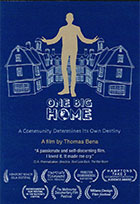
One Big Home 2016
Distributed by Bullfrog Films, PO Box 149, Oley, PA 19547; 800-543-FROG (3764)
Produced by Thomas Bena and James Holland
Directed by Thomas Bena
DVD , color, 88 min.
College - General Adult
Environment, Architecture, Housing, Development, Consumerism
Date Entered: 04/12/2018
Reviewed by Sharadha Natraj, University of Wisconsin Milwaukee, School of Architecture and Urban PlanningMartha’s Vineyard, off the coast of Massachusetts, is known for its natural beauty, and affluent and influential vacationing clientele, including Presidents and their families, who spend summers in homes nestled among trees or perched on bluffs overlooking the ocean. 57% of the homes on the island are occupied seasonally; a number that rises to 75% in the area of Chilmark. Summer population on Martha’s Vineyard is approximately 5 times the winter population. Sweeping aerial views in Thomas Bena’s multi-layered One Big Home show its crystal beaches and charming vistas. However, as the camera moves over the treetops, one sees large gashes in the earth, where new mega-mansions ranging from 15-20,000 sq. ft. are replacing old structures deemed too small for the new owners.
Over the course of the years it took to make the film, Bena tackles several issues that the construction of these new houses brings up. Overlays of old and current landscapes show the striking changes that development has made to the environment, with dense woods giving way to large swathes of lawn, tennis courts and swimming pools. Conversations peel back the overarching theme of McMansions to reveal nuanced insight into several other considerations, among them gentrification and the preservation of local character, development and economics, historical and environmental impact, and the tussle between free enterprise and regulation. Unlike the plots of land that the mansions are built on, none of these topics is clear-cut, and architects, building inspectors, academics and local residents are among those who present compelling arguments for both perspectives.
Bena’s film is, as the architect Peter Breese puts it in his interview, “documentary propaganda.” He has a point to make and attempts to convince the viewer of the perspective that big construction is wasteful. While trying to prove his thesis, however, he meets plenty of people who question it as well as his right to make such a judgement. As he follows the construction of these large homes and joins the community fight against them, a second thread is woven through the story; that of his growing family and his need for more space. These parallel stories present an interesting juxtaposition and brings to the forefront the issues surrounding individual property rights within a larger community culture. It would have been easy to present a one-sided, yet convincing argument to support Bena’s thesis. However, by honestly showing the complexities of the process and the people, this film provides a myriad of excellent starting points for discussions that are not restricted to development and local policy, but which could delve into social and historical areas as well.